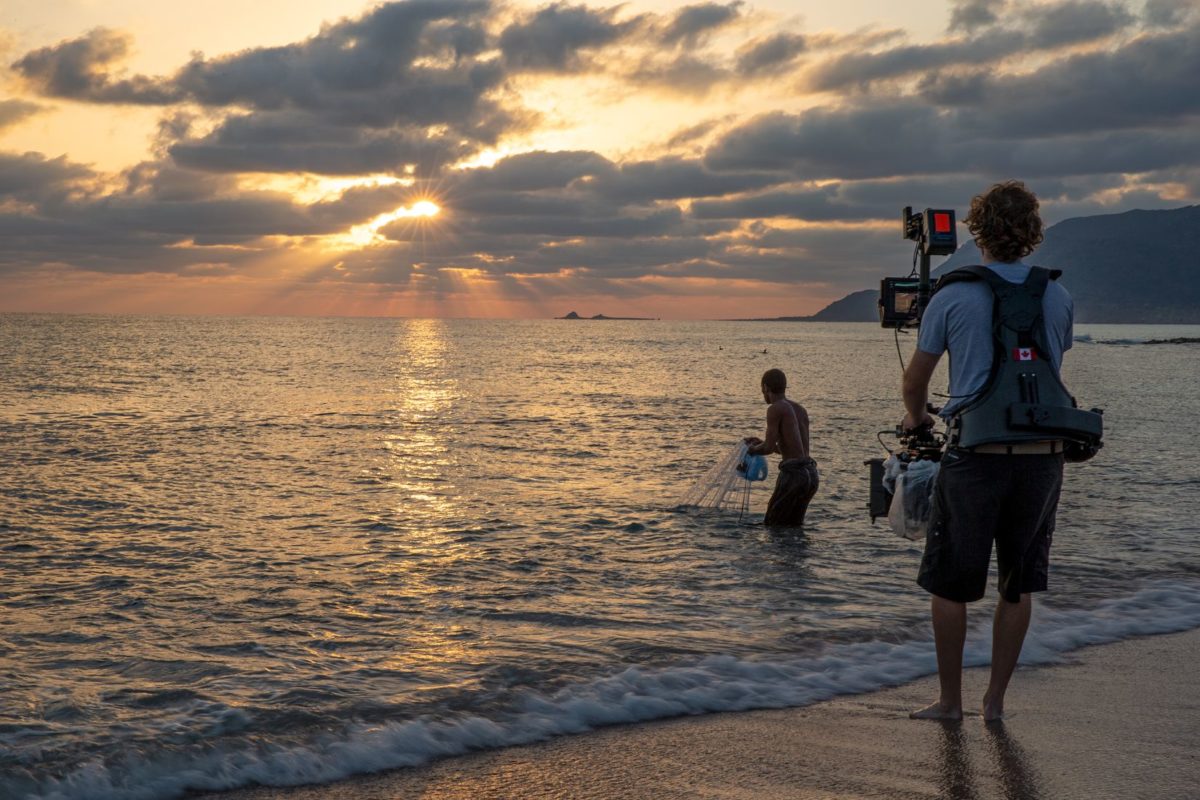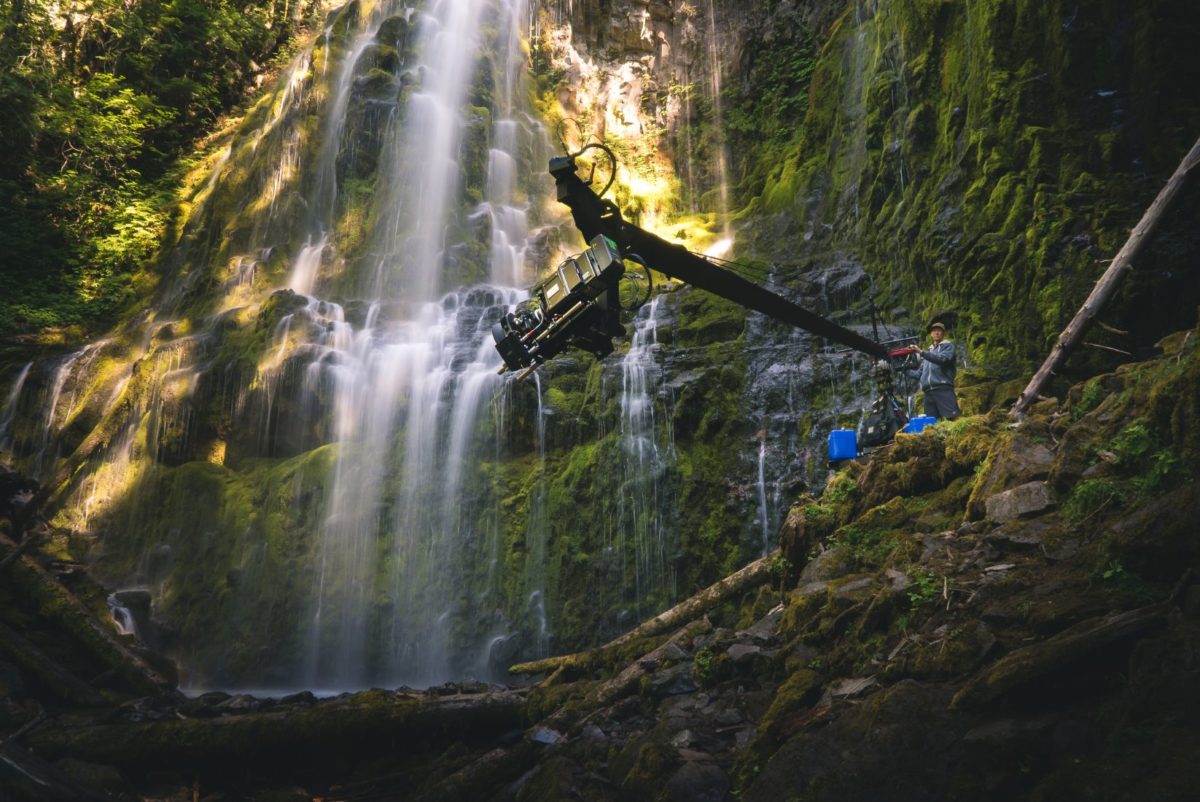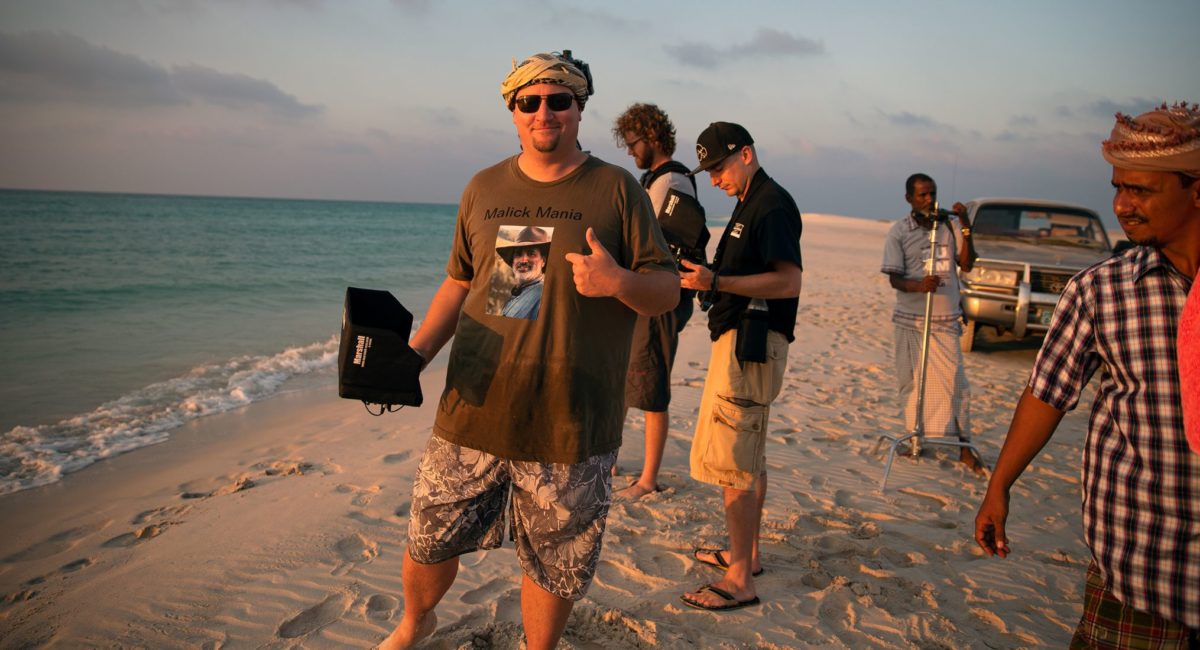After visiting over 30 countries over the span of half-a-decade, Tom Lowe’s non-narrative documentary AWAKEN is an awe-inspiring look at the bonds of nature and humanity. Executive produced by Terrence Malick and Godfrey Reggio–both of whom Lowe has collaborated with on various projects––the film is seemingly inspired by the spirit of Voyage of Time and Qatsi trilogy in its vision of the world.
I said in my review, “Shot in 4K over five years across 30 countries, Lowe orchestrates a non-narrative approach, letting the footage mostly speak for itself, accompanied by Joseph Trapanese’s bombastic orchestral score and sparsely doled-out, poetic voice-over from Liv Tyler. A visit to Dubai, where the film received its private funding for production, holds the most stunning imagery, as the camera floats ethereally above the sky as if created for a large-scale science-fiction film. The director’s previous experience with time-lapse footage of the vast wonders of the sky, in his 2012 medium-length film TimeScapes, comes into play again with staggering sequences of the night sky dawning and the aurora borealis.”
With the film now available digitally, we spoke with Lowe about the nearly decade-long process of making AWAKEN, the creativity of Asian cinema, what he learned from Terrence Malick and Godfrey Reggio, the technology behind the film, the desire for a new cut of Song to Song, and more.
The Film Stage: You’ve worked on this film for nearly a decade. Can you talk about the process from its inception to the release?
Tom Lowe: AWAKEN literally began at the wrap party and premiere of my first film Timescapes. A mutual friend approached and asked if they could get a screener of Timescapes for the Crown Prince of Dubai. A few days later I got a call asking if I could fly to London for a meeting. At this point, I’d been living in my car for years, sleeping on cots in the mountains and deserts, and hadn’t been on an airplane in about five years. Before that meeting my plan had been to move to China to make an IMAX film about China, but after a second meeting with the guys in Dubai we all agreed that we wanted to do something together, and AWAKEN was born. Originally it was supposed to be a 45-minute IMAX film about the Middle East, but within months we had expanded the scope to become a 45-minute worldwide IMAX documentary in the spirit of Baraka and Samsara. Eventually the budget was expanded from $4 million to $10 million and from 45 minutes to a feature documentary.

Can you discuss the technology used to film AWAKEN? Specifically, the timelapse footage and birds-eye-view shots are incredible.
AWAKEN was timed nicely with two major technological breakthroughs. First was the Phantom Flex 4K camera from Vision Research, which can shoot RAW UHD frames at 938 frames per second. Second was the introduction of commercially available fiber-optic gyros for camera stabilization.
At the beginning of Timescapes production in 2010 there were no viable options for 4K high-speed cinematography to appear alongside our super-high-resolution timelapse footage. An $800 Canon DSLR could easily outperform a $250,000 Sony F900/950 1080p cinema camera—the type George Lucas had used for Star Wars. The 1080p RGB footage looked godawful compared to the super-clean 4K+ RAW timelapse footage. That began to change around 2011 with the introduction of the Red Epic camera, which we used for nearly all of the slow-mo shots in Timescapes. But the Epic was limited to 60-to-90 fps.
The big game-changer for 4K super-slow-mo—the Phantom Flex 4K camera—arrived in the autumn of 2012, right when we started principle photography on AWAKEN. Our very first shot in the film was a girl riding a bicycle in Holland, filmed on a prototype Flex 4K. Like so much of the technology we would go on to use in AWAKEN, the Flex 4K was military tech repurposed for civilian use. That Flex 4K prototype didn’t even have a low-pass filter, which is why the shot of the bicycle girl looks so clean and gorgeous. I sent that Flex 4K demo footage of the Holland bicycle girl to Malick and Reggio immediately and both were very impressed and urged me to double down on that kind of footage. So finally we had slow-mo cameras that could match our timelapse cameras.
The other major breakthrough was the Shotover F1 camera-stabilization gimbal with fiber-optic gyros. The accuracy of these gyros was nuts. They were so stable, we could shoot 20-second exposures on Sony A7S2 cameras from helicopters in flight with pin-pointed stars, no blurring. Previously camera gimbals like the Cineflex had used mechanical gyros straight out of Sidewinder missiles, which were very accurate but suffered from terrible drift. With the Cineflex you might get 10 degrees of drift in just 5 minutes of filming, making them all but useless for timelapse. But the new fiber-optic gyros had insanely low bias-drift, which allowed us to film 2-hour timelapse shots from moving boats on Lake Powell with only one 1 or 2 degrees of drift. That opened up entire new categories of timelapse cinematography.
During the filming of Timescapes we’d spent a huge amount of time sitting around campfires under the stars dreaming up new ideas for timelapse shots, many of which revolved around helicopters. We’d been hugely inspired by the heli-timelapse shots from Ron Fricke in Samsara. So when Dubai came along and said they would fund all the heli shots I needed, that was the clincher. I was onboard.
You mentioned influences as wide-ranging as Wong Kar-wai, Hou Hsiao-hsien, Edward Yang, Christopher Doyle, Lee Ping-bing, Hayao Miyazaki, and Kenji Mizoguchi. Can you talk about these inspirations and any specific sequences from their work that you continue to revisit?
Well, Asia is running circles around Hollywood right now in terms of creativity. The West doesn’t have any equivalent to Hayao Miyazaki, in terms of imagination. You would need to look back to Walt Disney or Ray Harryhausen or George Lucas. Right now Hollywood is not primarily engaged in art or entertainment; they are preoccupied with promoting social agendas. They are hamstringing themselves. So if you find yourself competing against someone who is hamstringing themselves, it’s easier to win. This is why Asia is way out ahead in cinema. This is why anime is wildly popular.
In terms of cinematography influences on AWAKEN, I would place the Wong Kar-wai / Chris Doyle / Mark Lee Ping-bin axis near the top of the list, alongside Malick / Toll / Lubezki. Nearly everything I have learned about framing came from Wong Kar-wai films. When I think about slow-motion, I can draw a direct line from AWAKEN to the slow-mo scenes on the stairs from In the Mood for Love. When I think about “Z-axis” forward camera movement, I think about the opening shot of Millennium Mambo. Aesthetically, in terms of conveying meaning with images, sound, and few words, I would place a film like Hou Hsiao-hsien’s The Assassin miles above anything Hollywood has churned out in decades. Some of the more “staged,” fairytale-like scenes in AWAKEN were heavily inspired by Mizoguchi, particularly Ugetsu Monogatari.
There’s not a narrative, per se, in AWAKEN, but you definitely draw parallels in certain sequences such as the men fishing. Can you talk about your choices of structuring the film and if there’s an overarching message you were trying to convey?
I wanted the film to be mysterious. There is not enough mystery in our lives these days. So Kubrick’s 2001 was an inspiration. But the main structure of AWAKEN is mythological. It’s contained in the opening lines of Liv Tyler’s voiceover, referencing Pindar and the Greeks. Mythology is obviously super powerful, if a filmmaker can harness it, even at a subconscious level. When I was a kid I saw Clash of the Titans more than 20 times the summer it came out.
I also wanted AWAKEN to be able to work on multiple levels. If Joe Sixpack is watching the film, I wanted him to be able to enjoy the visceral journey of sight and sound without feeling lost or confused. The main message of AWAKEN is that while we are always on some quest to find Elysium, in reality Elysium is all around us.
In addition, did you have a blueprint for the structure of the film ahead of production or was it getting all the footage then finding the rhythm in the editing room?
I knew from day one that I wanted to explore humanity’s relationship with technology, so that was always the thematic driving focus. That’s why we filmed not only Blade Runner-style helicopter rides through cities, but also little kids riding reindeer in Mongolia wearing American baseball caps. That’s a somewhat more subtle way of documenting the onslaught of technology. Godfrey Reggio says that basically all of these non-verbal-narrative films are exploring that idea—man’s relationship with technology.
The main structure of the film didn’t really start coming together until 2015, once most of the principle photography was wrapped. That’s when I moved to Austin and started spending a lot more time with Malick and with the books and films that would ultimately lay the film’s editorial foundation.

Having collaborated with both Terrence Malick and Godfrey Reggio, both executive producers on AWAKEN, what did you learn most from them that informs your directorial style?
From both men I learned about the power of being humble, even if I don’t practice it very well. Both are philosophers, both are super well-read, both are troublemakers, and both are Mad Monk types—with Godfrey literally having been a Monk!
From Godfrey I learned a lot about filming long takes. With Visitors, Godfrey had me out filming these shots that were five or six minutes long. Some of those shots actually appear in Visitors, uncut. Filming long takes is difficult, because you need to hold the viewer’s attention and interest. The main trick is to make sure the shot “unfolds” in some way, that it becomes more interesting over time.
At a surface level, from Terry I picked up a lot of his filming dogma—“Z-axis” forward camera motion, wide-angle lenses, deep focus where possible. A lot of Malick’s cinematography style is aimed at making one feel immersed in scenes, which all of us thought would work well for an experiential documentary film like AWAKEN.
Specifically, with Malick, I think his post-The Tree of Life output is severely underrated and his experimental visual language will be more appreciated in the decades to come. What was it like working on the cinematography team for these projects and what were your thoughts after seeing the final films?
I agree with you very much on this, Jordan. What Terry will say is that with Knight of Cups and Song to Song and films of that era he was working on something like a new language. But you have to keep in mind that in many cases he was forced to put these films out before they were—in his mind—ready. He had contracts from financiers and distributors forcing him to release these films right when he was in the middle of figuring them out. He doesn’t use that as an excuse, but that’s what happened. I absolutely love those films. The scenes of Bale wandering the deserts out near Las Vegas could have been pulled directly from my own life. So much of that film hit home for me. The scenes with Fassbender and Natalie Portman tripping on drugs in Mexico in Song to Song are among my favorites from any film ever. I’ve been trying for years to get Malick to put out an alternate cut of Song to Song focusing more on the Fassbender character. That character and all the footage Terry has of him is lightning in a bottle. In terms of being iconic, I would put that character on the same kind of rare level as Gordon Gekko from Wall Street.

Tom Lowe and crew on location in Socotra, Yemen
There are many directors who have attempted to riff on Malick’s style, especially this past decade, but you really nail a certain patient and humble perspective that’s rare and akin to his work. Can you talk about authenticity vs. imitation when it comes to this approach?
Hmm, [that’s] hard to say. It probably has to come from life experiences, first and foremost. Terry and I have a lot in common in terms of our personality traits. I often joke that I am slowly turning into him. Both of us are a bit Autistic, quite OCD. So those are genuine, human-level similarities. But also keep in mind that I spent half a decade working under him, so the influence is very direct. If I sent him footage and he didn’t like it, I would learn very quickly that it was on the editing room floor and adjust my style. So probably a combination of those two things.
Were there any locations you visited to shoot that didn’t make it into the film?
Most of the locations we shot do not appear in AWAKEN. We have more than half a petabyte of RAW data. We could easily put out a 3-hour cut of AWAKEN if there was interest.
What’s next?
The 4K HDR Blu-ray of AWAKEN comes out in August and we are planning to do some specialty cinema screenings in the USA, Canada, Germany, and Dubai, a la Koyaanisqatsi, on Friday and Saturday nights at art-house theaters, Dolby and IMAX venues, and on these new LED cinema walls like the Samsung Onyx. If any exhibitors have interest in booking the film for specialty screenings, please contact Gunpowder & Sky or Kyle Greenberg at Circle Collective. We’d also love to find a permanent streaming home for the film.
I am currently writing a new fantasy film franchise called Alétheia, something on the scale of Star Wars and Lord of the Rings. The films will be visual-effects showcases, in the tradition of Ray Harryhausen, pioneering new machine-learning VFX, which I think will improve effects 5x while reducing costs by 10x. Right now the final barrier to competing with Hollywood blockbusters is VFX budgets, but AI technology will change that very soon and help to truly, once and for all, democratize filmmaking production.
AWAKEN is now available digitally. Explore more in Lowe’s videos below.
